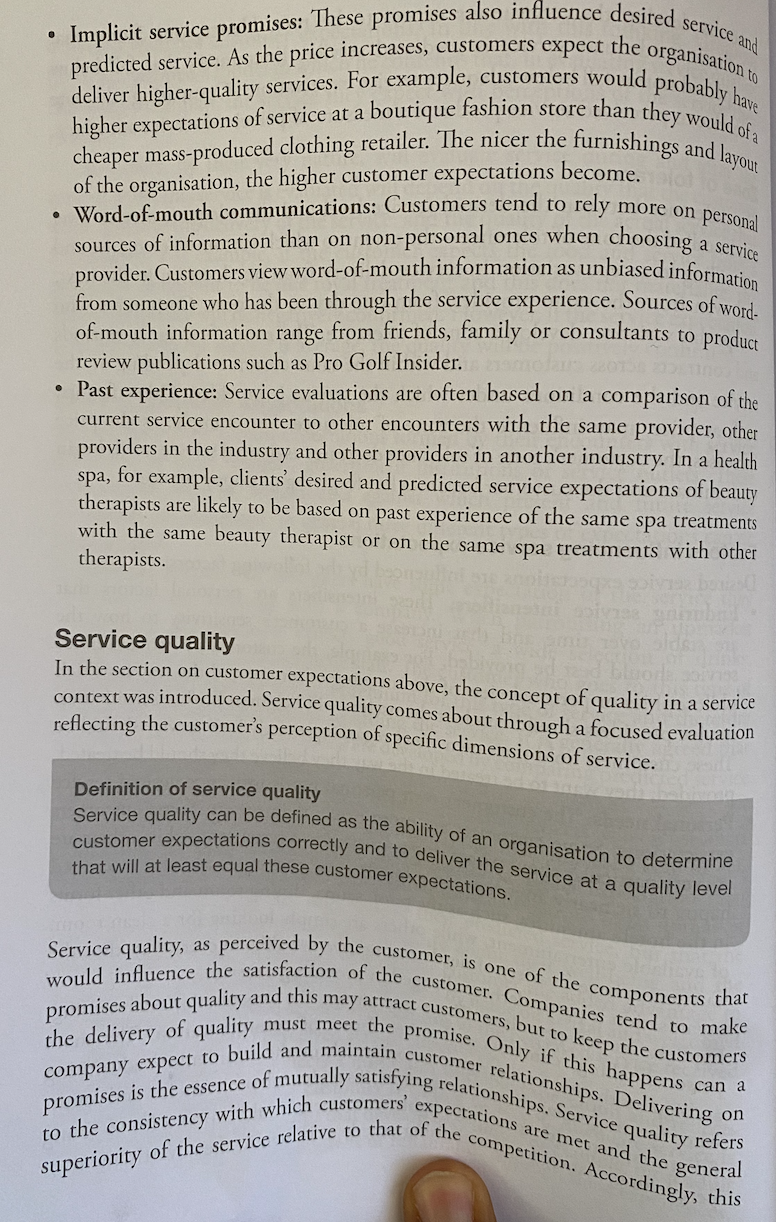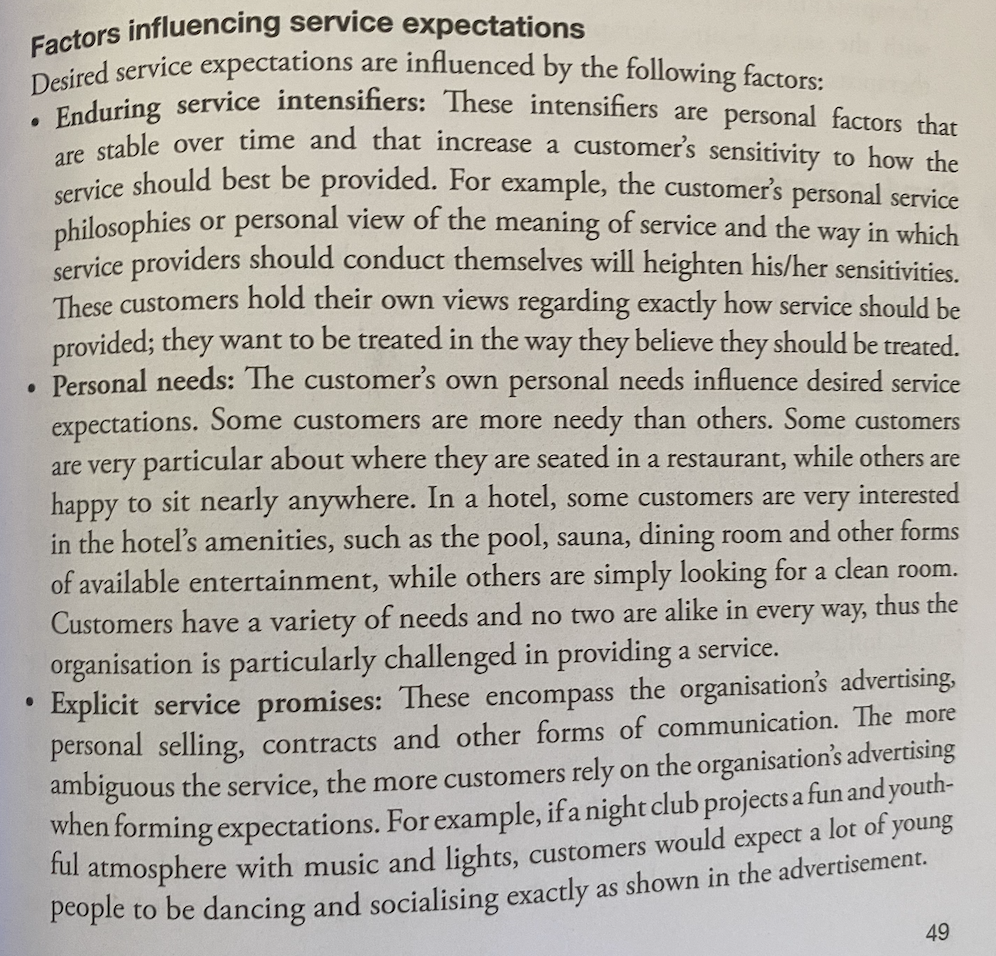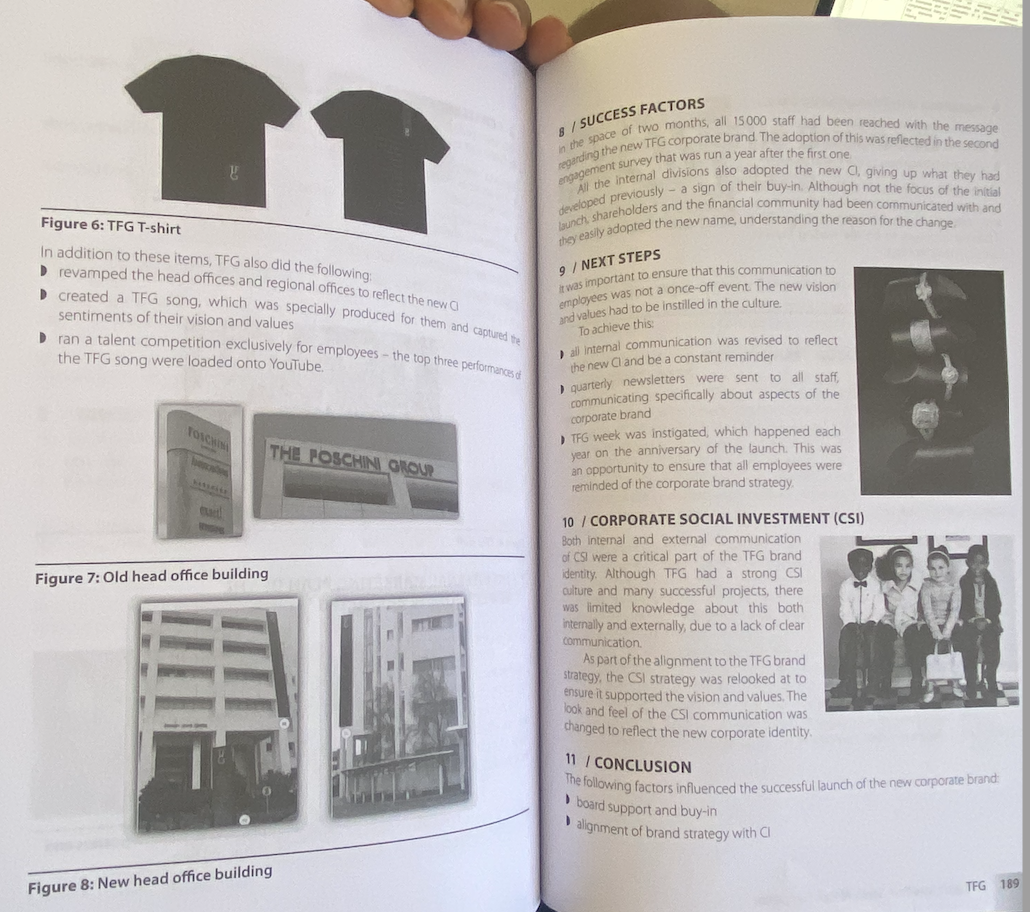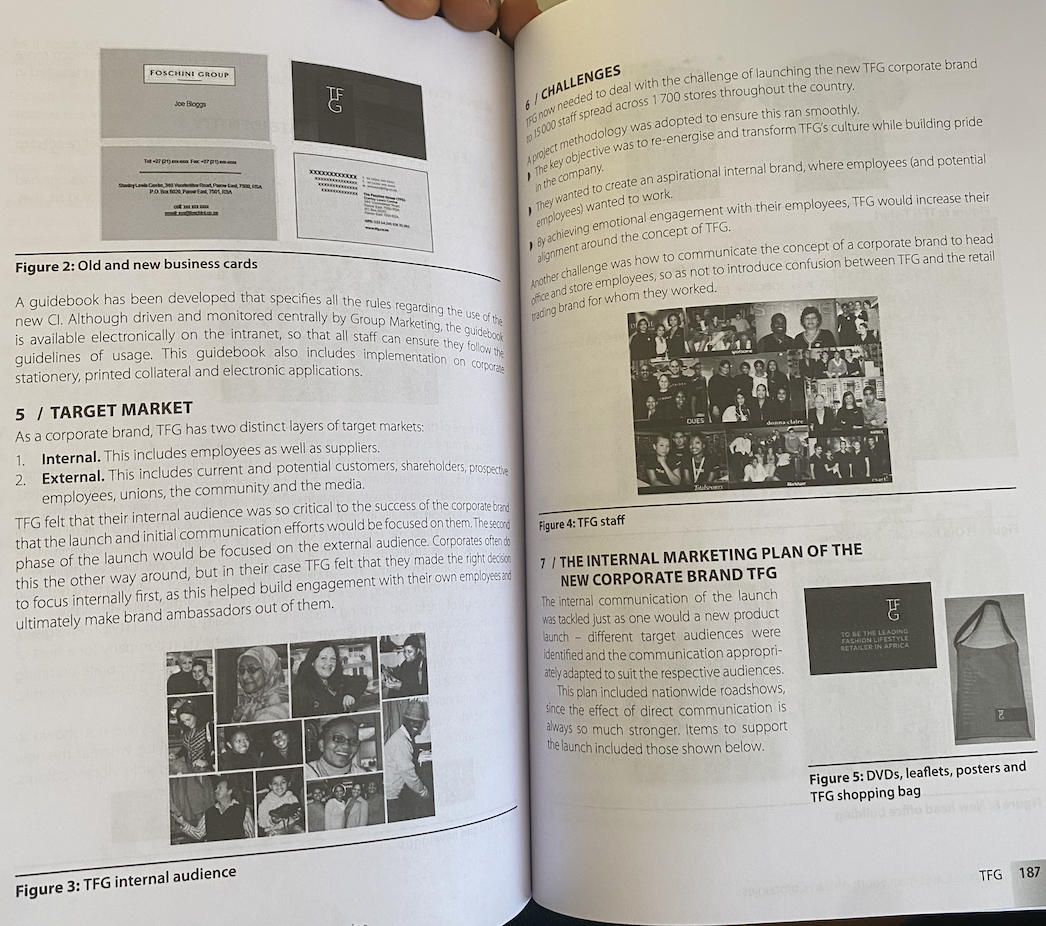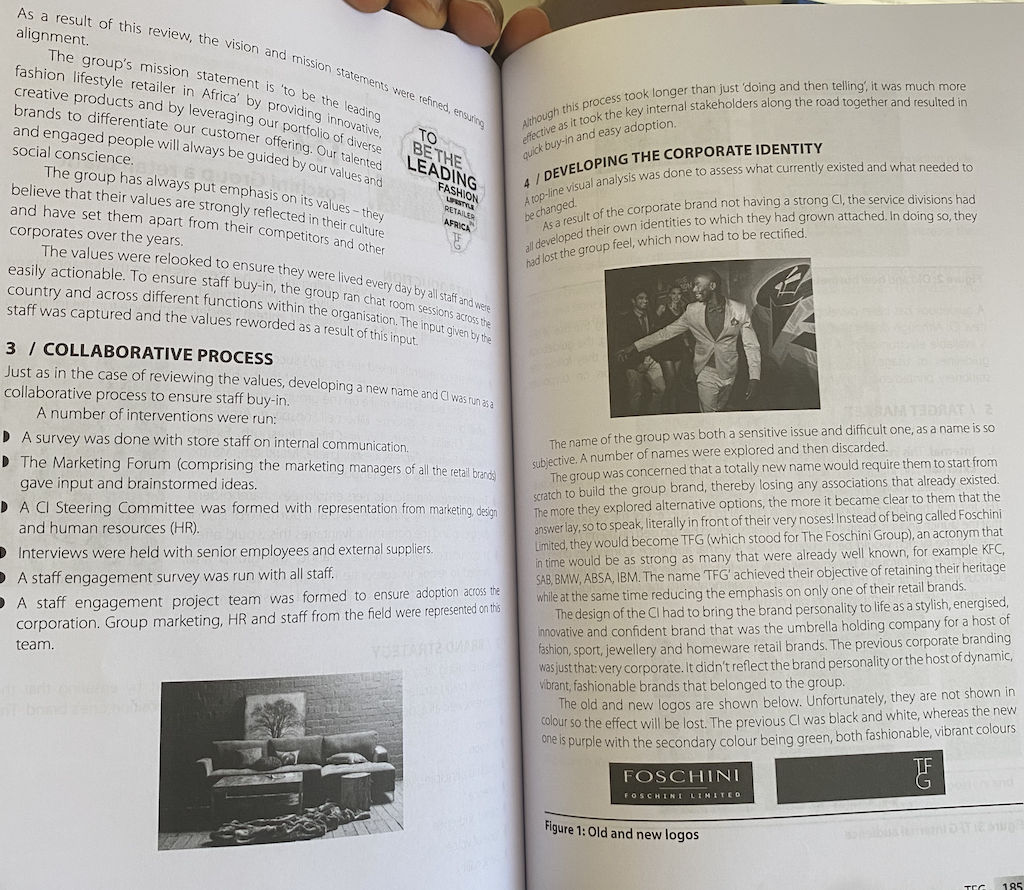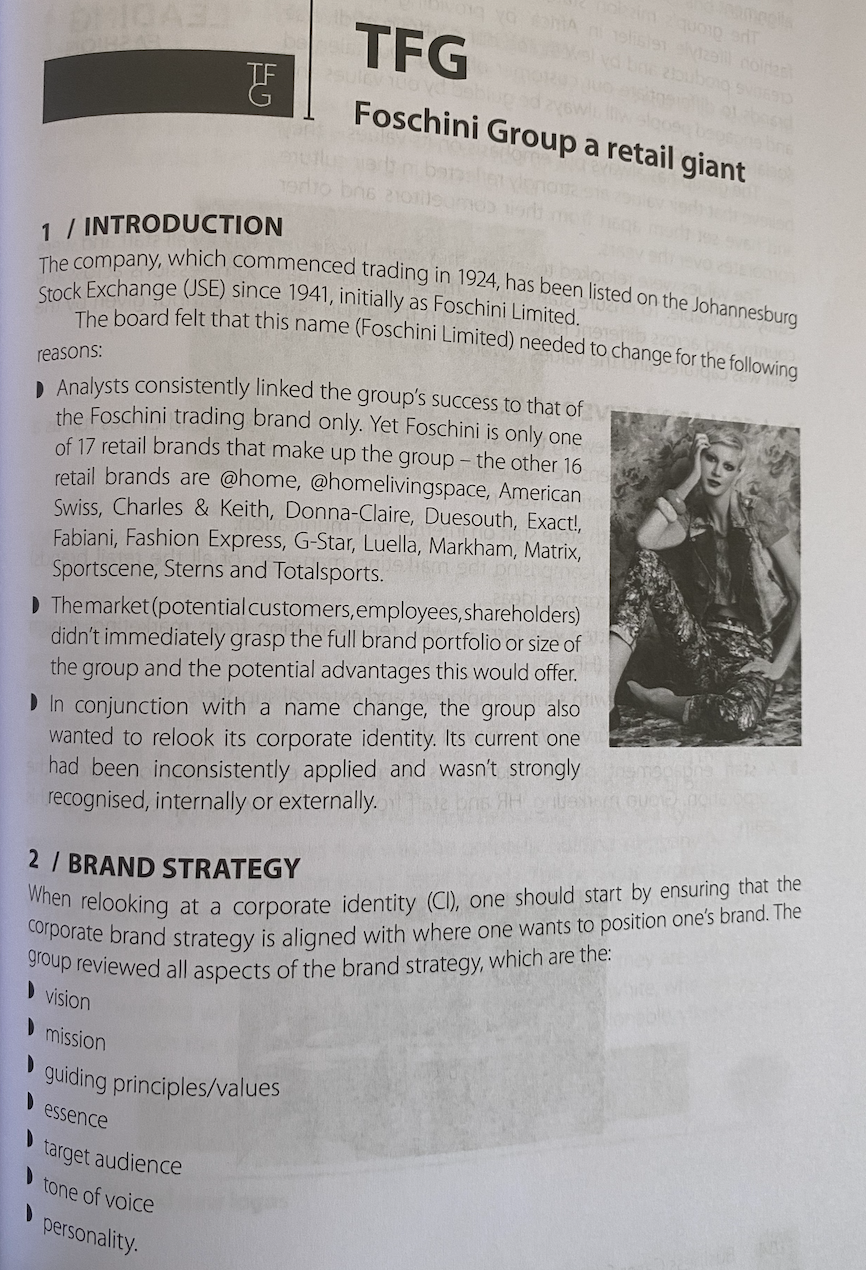. Implicit service promises: These promises also influence desired service and predicted service. As the price increases, customers expect the organisation for deliver higher-quality services. For example, customers would probably have higher expectations of service at a boutique fashion store than they would of ; cheaper mass-produced clothing retailer. The nicer the furnishings and layout of the organisation, the higher customer expectations become. . Word-of-mouth communications: Customers tend to rely more on personal sources of information than on non-personal ones when choosing a service provider. Customers view word-of-mouth information as unbiased information from someone who has been through the service experience. Sources of word- of-mouth information range from friends, family or consultants to product review publications such as Pro Golf Insider. . Past experience: Service evaluations are often based on a comparison of the current service encounter to other encounters with the same provider, other providers in the industry and other providers in another industry. In a health spa, for example, clients' desired and predicted service expectations of beauty therapists are likely to be based on past experience of the same spa treatments with the same beauty therapist or on the same spa treatments with other therapists. Service quality In the section on customer expectations above, the concept of quality in a service context was introduced. Service quality comes about through a focused evaluation reflecting the customer's perception of specific dimensions of service. Definition of service quality Service quality can be defined as the ability of an organisation to determine customer expectations correctly and to deliver the service at a quality level that will at least equal these customer expectations. Service quality, as perceived by the customer, is one of the components that would influence the satisfaction of the customer. Companies tend to make promises about quality and this may attract customers, but to keep the customer the delivery of quality must meet the promise. Only if this happens can " company expect to build and maintain customer relationships. Delivering off promises is the essence of mutually satisfying relationships. Service quality refers to the consistency with which customers expectations are met and the general superiority of the service relative to that of the competition. Accordingly, thisFactors influencing service expectations Desired service expectations are influenced by the following factors: . Enduring service intensifies: These intensifies are personal factors that are stable over time and that increase a customer's sensitivity to how the service should best be provided. For example, the customer's personal service philosophies or personal view of the meaning of service and the way in which service providers should conduct themselves will heighten his/her sensitivities. These customers hold their own views regarding exactly how service should be provided; they want to be treated in the way they believe they should be treated. . Personal needs: The customer's own personal needs influence desired service expectations. Some customers are more needy than others. Some customers are very particular about where they are seated in a restaurant, while others are happy to sit nearly anywhere. In a hotel, some customers are very interested in the hotel's amenities, such as the pool, sauna, dining room and other forms of available entertainment, while others are simply looking for a clean room. Customers have a variety of needs and no two are alike in every way, thus the organisation is particularly challenged in providing a service. . Explicit service promises: These encompass the organisation's advertising, personal selling, contracts and other forms of communication. The more ambiguous the service, the more customers rely on the organisation's advertising when forming expectations. For example, if a night club projects a fun and youth- ful atmosphere with music and lights, customers would expect a lot of young people to be dancing and socialising exactly as shown in the advertisement. 49B / SUCCESS FACTORS In the space of two months, all 15000 staff had been reached with the message regarding the new TFG corporate brand. The ado The adoption of this was reflected in the second engagement survey that was run a year after the first one All the internal divisions also adopted the new Cl, giving up what they had developed previously - a sign of their buy-in. Although not the focus of the initial Figure 6: TFG T-shirt launch shareholders and the financial community had been communicated with and they easily adopted the new name, understanding the reason for the change. In addition to these items, TFG also did the following: 9 / NEXT STEPS revamped the head offices and regional offices to reflect the new it was important to ensure that this communication to created a TFG song, which was specially produced for them and captured the employees was not a once-off event. The new vision sentiments of their vision and values and values had to be instilled in the culture. To achieve this: ran a talent competition exclusively for employees - the top three performances of the TFG song were loaded onto YouTube. ) all internal communication was revised to reflect the new Cl and be a constant reminder I quarterly newsletters were sent to all staff, communicating specifically about aspects of the corporate brand TFG week was instigated, which happened each THE FOSCHINI GROUP year on the anniversary of the launch. This was an opportunity to ensure that all employees were reminded of the corporate brand strategy. 10 / CORPORATE SOCIAL INVESTMENT (CSI) Both Internal and external communication of CSI were a critical part of the TFG brand Figure 7: Old head office building identity. Although TFG had a strong CSI culture and many successful projects, there was limited knowledge about this both internally and externally, due to a lack of clear communication. As part of the alignment to the TFG brand strategy, the CSI strategy was relooked at to ensure it supported the vision and values. The look and feel of the CSI communication was changed to reflect the new corporate identity. 11 / CONCLUSION The following factors influenced the successful launch of the new corporate brand: board support and buy-in alignment of brand strategy with CI Figure 8: New head office building TFG 189FOSCHINI GROUP Joe Blogs 6 / CHALLENGES no now needed to deal with the challenge of launching the new TFG corporate brand 15000 staff spread across 1 700 stores throughout the country. A project methodology was adopted to ensure this ran smoothly. The key objective was to re-energise and transform TFG's culture while building pride in the company . They wanted to create an aspirational internal brand, where employees (and potential employees) wanted to work. By achieving emotional engagement with their employees, TFG would increase their Figure 2: Old and new business cards alignment around the concept of TFG. Another challenge was how to communicate the concept of a corporate brand to head A guidebook has been developed that specifies all the rules regarding the use of the ofice and store employees, so as not to introduce confusion between TFG and the retail new Cl. Although driven and monitored centrally by Group Marketing, the guidebook trading brand for whom they worked. is available electronically on the intranet, so that all staff can ensure they follow the guidelines of usage. This guidebook also includes implementation on corporate stationery, printed collateral and electronic applications. 5 / TARGET MARKET As a corporate brand, TFG has two distinct layers of target markets: Internal. This includes employees as well as suppliers. External. This includes current and potential customers, shareholders, prospective employees, unions, the community and the media. TFG felt that their internal audience was so critical to the success of the corporate brand that the launch and initial communication efforts would be focused on them. The second Figure 4: TFG staff phase of the launch would be focused on the external audience. Corporates often do this the other way around, but in their case TFG felt that they made the right decision 7 / THE INTERNAL MARKETING PLAN OF THE to focus internally first, as this helped build engagement with their own employees and NEW CORPORATE BRAND TFG ultimately make brand ambassadors out of them. The internal communication of the launch was tackled just as one would a new product aunch - different target audiences were identified and the communication appropri- TO BE THE LEADING RETAILER IN AFRICA ately adapted to suit the respective audiences. This plan included nationwide roadshows, since the effect of direct communication is always so much stronger. Items to support the launch included those shown below. Figure 5: DVDs, leaflets, posters and TFG shopping bag Figure 3: TFG internal audience TFG 187alignment. As a result of this review, the vision and mission statements were refined, ensuring The group's mission statement is 'to be the leading fashion lifestyle retailer in Africa' by providing innovative, creative products and by leveraging our portfolio of diverse Although this process took longer than just 'doing and then telling', it was much more efective as it took the key internal stakeholders along the road together and resulted in brands to differentiate our customer offering. Our talented TO quick buy-in and easy adoption. and engaged people will always be guided by our values and social conscience. BETHE LEADING 4 / DEVELOPING THE CORPORATE IDENTITY The group has always put emphasis on its values - they A top-line visual analysis was done to assess what currently existed and what needed to FASHION believe that their values are strongly reflected in their culture RETAILER be changed. As a result of the corporate brand not having a strong Cl, the service divisions had and have set them apart from their competitors and other AFRICA corporates over the years. all developed their own identities to which they had grown attached. In doing so, they had lost the group feel, which now had to be rectified. The values were relooked to ensure they were lived every day by all staff and were easily actionable. To ensure staff buy-in, the group ran chat room sessions across the country and across different functions within the organisation. The input given by the staff was captured and the values reworded as a result of this input. 3 / COLLABORATIVE PROCESS Just as in the case of reviewing the values, developing a new name and I was run as a collaborative process to ensure staff buy-in. A number of interventions were run: AM THERAT A A survey was done with store staff on internal communication. The name of the group was both a sensitive issue and difficult one, as a name is so subjective. A number of names were explored and then discarded. The Marketing Forum (comprising the marketing managers of all the retail brands) The group was concerned that a totally new name would require them to start from gave input and brainstormed ideas. scratch to build the group brand, thereby losing any associations that already existed. A CI Steering Committee was formed with representation from marketing, design The more they explored alternative options, the more it became clear to them that the and human resources (HR). answer lay, so to speak, literally in front of their very noses! Instead of being called Foschini Interviews were held with senior employees and external suppliers. limited, they would become TFG (which stood for The Foschini Group), an acronym that in time would be as strong as many that were already well known, for example KFC, A staff engagement survey was run with all staff. SAB, BMW, ABSA, IBM. The name TFG' achieved their objective of retaining their heritage A staff engagement project team was formed to ensure adoption across the while at the same time reducing the emphasis on only one of their retail brands. corporation. Group marketing, HR and staff from the field were represented on this The design of the CI had to bring the brand personality to life as a stylish, energised innovative and confident brand that was the umbrella holding company for a host of team. YERTART2 GUARD ashion, sport, jewellery and homeware retail brands. The previous corporate branding was just that very corporate. It didn't reflect the brand personality or the host of dynamic, vibrant, fashionable brands that belonged to the group. The old and new logos are shown below. Unfortunately, they are not shown in colour so the effect will be lost. The previous CI was black and white, whereas the new one is purple with the secondary colour being green, both fashionable, vibrant colours FOSCHINI FOSCHINI LIMITED Figure 1: Old and new logosTFG islister elizalil coinlas Foschini Group a retail giant mutlus wart ni bore her vienonesi 1 / INTRODUCTION The company, which commenced trading in 1924, has been listed on the Johannesburg Stock Exchange (JSE) since 1941, initially as Foschini Limited. The board felt that this name (Foschini Limited) needed to change for the following reasons: Analysts consistently linked the group's success to that of the Foschini trading brand only. Yet Foschini is only one of 17 retail brands that make up the group - the other 16 retail brands are @home, @homelivingspace, American Swiss, Charles & Keith, Donna-Claire, Duesouth, Exact!, Fabiani, Fashion Express, G-Star, Luella, Markham, Matrix, Sportscene, Sterns and Totalsports. Themarket (potential customers, employees, shareholders) didn't immediately grasp the full brand portfolio or size of the group and the potential advantages this would offer. In conjunction with a name change, the group also wanted to relook its corporate identity. Its current one had been inconsistently applied and wasn't strongly recognised, internally or externally. 2 / BRAND STRATEGY When relooking at a corporate identity (CI), one should start by ensuring that the corporate brand strategy is aligned with where one wants to position one's brand. The group reviewed all aspects of the brand strategy, which are the: vision mission guiding principles/values essence target audience tone of voice personality
